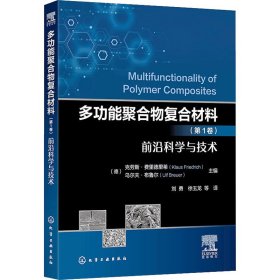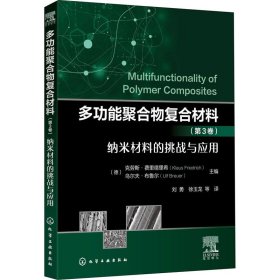
基于聚合物的多功能纳米复合材料
¥ 135.8 9.1折 ¥ 149 九五品
仅1件
作者宋克男(KenanSong),刘春太(ChuntaiLiu)
出版社高等教育出版社
ISBN9787040525885
出版时间2019-09
版次1
装帧精装
开本16开
纸张胶版纸
页数328页
定价149元
上书时间2024-06-03
- 最新上架
商品详情
- 品相描述:九五品
- 商品描述
-
基本信息
书名:基于聚合物的多功能纳米复合材料
定价:149.00元
作者:宋克男(KenanSong),刘春太(ChuntaiLiu),郭占虎
出版社:高等教育出版社
出版日期:2019-09-01
ISBN:9787040525885
字数:
页码:328
版次:
装帧:精装
开本:16开
商品重量:
编辑推荐
内容提要
《基于聚合物的多功能纳米复合材料(英文版)》由国际专家研究小组编辑和撰写,整合了多功能纳米复合材料及其应用的基础知识、研究和开发的进展,以及由此产生的多功能聚合物及其纳米复合材料的多样性介绍。 《基于聚合物的多功能纳米复合材料(英文版)》还详细介绍了结构纳米复合材料中多功能组合的广泛应用,包括运输工程、机械系统、航空航天制造、建筑材料、电气元件、生物医学设备以及光学组件等领域。
目录
ContributorsPreface1.Nanoparticles and Nanocomposites With Microfluidic TechnologyZhenhao Tian, Xuehui Ge,Yujun Wang and Danhong Xu1.1 Introduction1.2 Microfluidic Platforms for Nanoparticles and Nanocomposites Synthesis1.2.1 The Types and Fabrication Techniques of Microfluidic Platforms1.2.2 Flow Patterns1.3 Synthesis of Organic Nanoparticles by Microreactors1.4 Synthesis of Inorganic Nanoparticles by Microreactor1.4.1 MetaI Nanoparticles1.4.2 Metal Ode Nanoparticles1.4.3 Quantum Dots1.5 Inorganic Hybrid Nanoparticles and Nanocomposites1.5.1 Metal Alloy Materials1.5.2 Core-Shell Quantum Dots1.6 Organic Hybrid Functional Nanoparticles Synthesis and Their Applications for Drug Delivery1.7 Conclusions and OutlooksAcknowledgementsReferences2.Cluster Beam Synthesis of Polymer Compositeswith NanoparticlesVladimir N.Popok2.1 Introduction2.1.1 Functionalities of Polymers with Nanoparticles2.1.2 Synthesis of Polymers with NPs2.2 Formation of Cluster Beams2.2.1 Cluster Nucleation and Growth2.2.2 Cluster Sources2.3 Cluster Deposition/Embedment on/in Polymers2.3.1 Fundamental Aspects of Nanoparticle Interactionwith Polymer Surfaces2.3.2 Deposition and Implantation of Clusters2.4 Properties of Polymer Composites With Nanoparticles2.5 Applications of Nanocomposite Polymer Films2.5.1 Formation of Electronic Components2.5.2 Nanocomposites in Optics and Photovoltaics2.5.3 Polymer Nanocomposites for Biological Applications2.6 ConclusionsReferences3.Thermal Conduction in Polymer CompositesNitin Mehra, Liwen Mu, Tuo ji and jiahua Zhu3.1 Introduction3.2 Fundamentals of Phonon Transport in Solid Materials3.3 Thermal Conduction in Polymers3.3.1 Why Are Polymers Traditionally Called ThermalInsulators?3.3.2 Factors Playing a Critical Role in ThermalConduction in Polymers3.4 Thermal Conduction in Polymer Composites3.4.1 Challenges3.4.2 Carbon Filler-Based Polymer Composites3.4.3 Ceramic Filler-Based Polymer Composites3.4.4 Metallic Filler-Based Polymer Composites3.5 Strategies to Enhance Thermal Conduction3.5.1 Filler Alignment3.5.2 Filler Surface Modification3.5.3 Hybrid Fillers3.5.4 Other Strategies and Materials3.6 Applications3.7 Thermally Insulative Materials3.8 Summaries and OutlooksReferences4.Epoxy-Based Multifunctional NanocompositesKhalid A.Askar and Kenan Song4.1 Introduction4.2 Composite Preparations4.3 Mechanical Reinforcements4.4 Wear Resistance4.5 Self-Cleaning4.6 Self-Healing4.7 ConclusionsReferences……5.Self-Healing Fiber Composites With a Self-Pressurized Healing System6.Multifunctional Nanocomposite Sensors for Environmental Monitorin7.Nanocomposites for Biomedical Applications8.Polymer-Based Nanocomposites with High Dielectric Permittivity9.Proton-Conducting Materials Used as Polymer Electrolyte Membranes in Fuel Cells10.Smart Adhesion Surfaces11.Flame Retardancy of Wood-Polymeric CompositesIndex
作者介绍
Kenan Song(宋克男),美国亚利桑那州立大学助理教授,重点研究领域为聚合物基纳米粒子填充复合材料的制造、表征、模拟和应用,感兴趣的研究方向为一维纳米管、二维纳米芯片以及零维纳米球等。申请美国专利1项,合作出版学术著作4部,在ACS Applied Materials&Interlaces、Carbon、Polymer等期刊发表论文13篇,目前为50多种学术期刊的评论员和编委。 Chuntai Liu(刘春太),郑州大学教授,郑州大学橡塑模具国家工程研究中心常务副主任,广东轻工职业技术学院珠江学者讲席教授,全国模具标准化技术委员会主任委员,主要研究方向为高分子及其复合材料成型加工。发表SCI论文150余篇,曾获“中国载人航天工程突出贡献”奖励和国家科技进步二等奖2项。 John Zhanhu Guo(郭占虎),美国田纳西大学诺克斯维尔分校副教授,ICL实验室主任,主要研究方向为纳米结构材料、聚合物纳米合成、纳米制造、超导聚合物纳米合成、环境可持续发展、能源效率提高等。担任国际学术期刊Advanced Composites and Hvbrid Materials主编、Engineerefl Science 执行主编以及多家国际学术期刊编委。
序言
ContributorsnPrefacen1.Nanoparticles and Nanocomposites With Microfluidic TechnologynZhenhao Tian, Xuehui Ge,Yujun Wang and Danhong Xun1.1 Introductionn1.2 Microfluidic Platforms for Nanoparticles and Nanocomposites Synthesisn1.2.1 The Types and Fabrication Techniques of Microfluidic Platformsn1.2.2 Flow Patternsn1.3 Synthesis of Organic Nanoparticles by Microreactorsn1.4 Synthesis of Inorganic Nanoparticles by Microreactorn1.4.1 MetaI Nanoparticlesn1.4.2 Metal Oxide Nanoparticlesn1.4.3 Quantum Dotsn1.5 Inorganic Hybrid Nanoparticles and Nanocompositesn1.5.1 Metal Alloy Materialsn1.5.2 Core-Shell Quantum Dotsn1.6 Organic Hybrid Functional Nanoparticles Synthesis and Their Applications for Drug Deliveryn1.7 Conclusions and OutlooksnAcknowledgementsnReferencesnn2.Cluster Beam Synthesis of Polymer Compositesnwith NanoparticlesnVladimir N.Popokn2.1 Introductionn2.1.1 Functionalities of Polymers with Nanoparticlesn2.1.2 Synthesis of Polymers with NPsn2.2 Formation of Cluster Beamsn2.2.1 Cluster Nucleation and Growthn2.2.2 Cluster Sourcesn2.3 Cluster Deposition/Embedment on/in Polymersn2.3.1 Fundamental Aspects of Nanoparticle Interactionnwith Polymer Surfacesn2.3.2 Deposition and Implantation of Clustersn2.4 Properties of Polymer Composites With Nanoparticlesn2.5 Applications of Nanocomposite Polymer Filmsn2.5.1 Formation of Electronic Componentsn2.5.2 Nanocomposites in Optics and Photovoltaicsn2.5.3 Polymer Nanocomposites for Biological Applicationsn2.6 ConclusionsnReferencesnn3.Thermal Conduction in Polymer CompositesnNitin Mehra, Liwen Mu, Tuo ji and jiahua Zhun3.1 Introductionn3.2 Fundamentals of Phonon Transport in Solid Materialsn3.3 Thermal Conduction in Polymersn3.3.1 Why Are Polymers Traditionally Called ThermalnInsulators?n3.3.2 Factors Playing a Critical Role in ThermalnConduction in Polymersn3.4 Thermal Conduction in Polymer Compositesn3.4.1 Challengesn3.4.2 Carbon Filler-Based Polymer Compositesn3.4.3 Ceramic Filler-Based Polymer Compositesn3.4.4 Metallic Filler-Based Polymer Compositesn3.5 Strategies to Enhance Thermal Conductionn3.5.1 Filler Alignmentn3.5.2 Filler Surface Modificationn3.5.3 Hybrid Fillersn3.5.4 Other Strategies and Materialsn3.6 Applicationsn3.7 Thermally Insulative Materialsn3.8 Summaries and OutlooksnReferencesnn4.Epoxy-Based Multifunctional NanocompositesnKhalid A.Askar and Kenan Songn4.1 Introductionn4.2 Composite Preparationsn4.3 Mechanical Reinforcementsn4.4 Wear Resistancen4.5 Self-Cleaningn4.6 Self-Healingn4.7 ConclusionsnReferencesn……n5.Self-Healing Fiber Composites With a Self-Pressurized Healing Systemn6.Multifunctional Nanocomposite Sensors for Environmental Monitorinn7.Nanocomposites for Biomedical Applicationsn8.Polymer-Based Nanocomposites with High Dielectric Permittivityn9.Proton-Conducting Materials Used as Polymer Electrolyte Membranes in Fuel Cellsn10.Smart Adhesion Surfacesn11.Flame Retardancy of Wood-Polymeric CompositesnIndex
-

【封面】
相关推荐
-

基于聚合物的多功能纳米复合材料(英文版)
全新无锡
¥ 116.47
-

基于聚合物的多功能纳米复合材料(英文版)
全新北京
¥ 111.75
-

基于聚合物的多功能纳米复合材料 (英文版)
九五品安庆
¥ 40.00
-

基于聚合物的多功能纳米复合材料(英文版)
全新北京
¥ 111.75
-

基于聚合物的多功能纳米复合材料(英文版)
全新北京
¥ 116.22
-

基于聚合物的多功能纳米复合材料(英文版)
八五品廊坊
¥ 22.00
-

多功能聚合物复合材料(第2卷)
全新南京
¥ 71.28
-

多功能聚合物复合材料(第1卷)
全新南京
¥ 71.28
-

多功能聚合物复合材料(第3卷)
全新南京
¥ 71.28
-

多功能聚合物复合材料(第3卷)
全新南京
¥ 71.28
— 没有更多了 —











以下为对购买帮助不大的评价